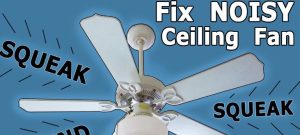“Does my ceiling fan need oiling?” Some ceiling fans are designed to be oiled, others are designed to “never” need oiling. However all moving parts require lubrication, and no oil or grease will will last forever. So even fans claiming to have permanently sealed and/or lubricated bearings may need oil at some point. As described below, there are many fans that require oiling. Hunter Original models and those based from it will require oiling, for an example. Continue to read below to learn more information about what ceiling fan models do require oiling, and which do not.
Fans that are designed to be oiled should be oiled on a regular basis, some would say annually. The most popular “oil bath” model is the Hunter Original. Many fan designs based on the Hunter Original also require oiling, this includes models by Classic Fans, Evergo, Leslie-Locke, Montgomery Ward, Robbins & Myers, and Kenroy. Any fan made prior to 1970 is likely designed to be oiled. Beyond that there are a few other factors you can look for if you’re not sure. The oil hole will usually be on top of the motor near the downrod and will sometimes be labeled. Models designed to be oiled usually are of cast iron construction and weigh significantly more than conventional fans i.e. 40lbs or so. And in most cases when a fan is designed to be oiled the motor windings are visible through the vent holes in the bottom of the motor housing. With these fans, the motor usually fills the entire motor housing, whereas with motors with sealed bearings, there is often a lot of space inside the motor housing.
Fans not designed to be oiled may still require oiling if the bearings become dry, dirty or gummed with time and use. If the blades do not turn freely by hand and coast, or if there is a grinding, rubbing, or ticking noise as they spin, the bearings likely need oil (see ‘troubleshooting guide‘. This is more likely to occur when the fan is run a lot, and/or in dirty, dusty and/or smoky conditions. There is no such thing as a ‘permanently sealed bearing’, over time that just means that as the dirt gets in it cant get back out again.
In all cases the oil needed will be a 10, 15, or 20 weight non-detergent motor oil. Do not use oils with detergents as they will gum the bearings. 3-in-1 oil is not recommended, and WD40 is NOT a motor oil. WD40 can work very well for cleaning exceptionally dirty bearings, however it is not a thick enough lubricant to prevent friction among moving parts, if a bearing is cleaned with WD40 it should be THOROUGHLY oiled with the proper oil afterwards. Light weight non-detergent motor oils can be found at many auto parts stores as well as farm supply stores. It should cost $1-3 for a quart, or you can buy smaller amounts for similar prices where an applicator is included. Hunter bottles it’s own oil for it’s Original model, this the same as any similar oil but it may be convenient.

Having a squeaky, annoying ceiling fan is never fun for anyone! The good news is that while newer fans don’t require oiling, older fans that do need oiling don’t need it very often, and the oil is not overly expensive. Annual is fine. Check if your ceiling fan has a oil reservoir hole by following the instructions on this page.
For fans designed to be oiled, simply fill the reservoir with oil via the oil hole. Unless the fan is completely dry or the oil has been drained, 1 or 2 ounces should be enough. In the event the fan is devoid of oil you will want to fill it completely. If the bearings are gummed or dirty you may want to fill it with oil, spin the rotor until it moves freely, and then drain and re-oil. In severe cases you may want to first fill the reservoir with degreaser such as WD40 or tuner cleaner, drain that (or allow it to dry) and then fill with oil. You can also disassemble the fan and clean the reservoir and bearings by hand, if this is necessary and you do not feel comfortable doing so without instructions please contact us.
Fans with sealed bearings that require oil . . . this can be a bit more tricky. You will want to remove the blades and remove the motor from the ceiling. Once the motor is down remove the motor casing to better access the motor. The best thing to do is to disassemble the motor itself by removing the stator from the end bells, this will allow full access to the bearings and they can be thoroughly oiled. However if you are not comfortable and knowledgeable enough to do so, in many cases a motor can be oiled without disassembly. Observe the motor shaft, where the rotating parts meet the stationary parts. The small seam there is the edge of the bearing, and often times slowly applying oil there will run into the bearing. On some motors both the top and bottom bearings are accessible in this manner, in others it is only the bottom bearing. Again if further disassembly is required and you require further instruction, email.
One last note: bearings that are particularly dirty or worn can be replaced. The motor has to be disassembled, in which case they can be pulled or punched out. Replacements are readily available at motor and bearing shops.